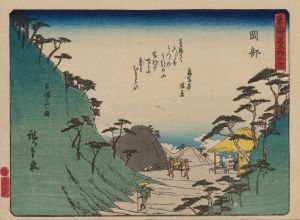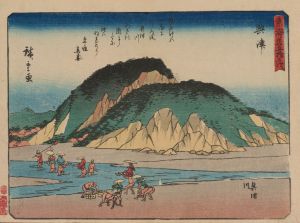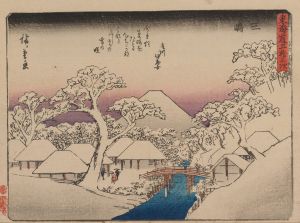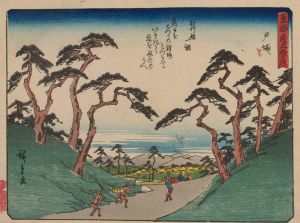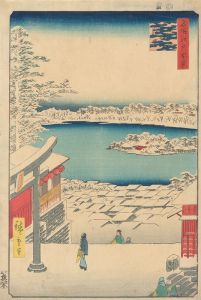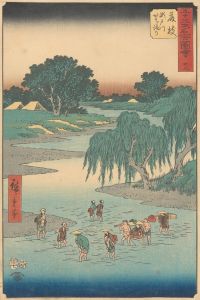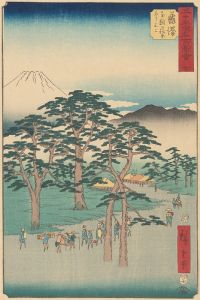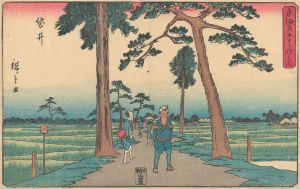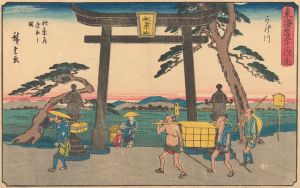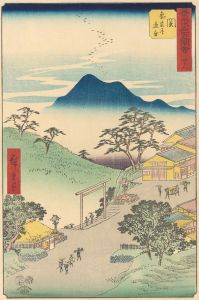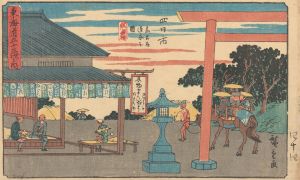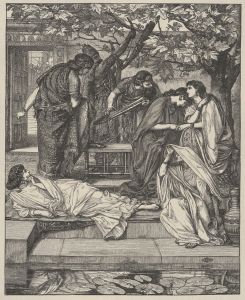
Tokaido gojusantsugi, Pl.27
A hand-painted replica of Andō Hiroshige’s masterpiece Tokaido gojusantsugi, Pl.27, meticulously crafted by professional artists to capture the true essence of the original. Each piece is created with museum-quality canvas and rare mineral pigments, carefully painted by experienced artists with delicate brushstrokes and rich, layered colors to perfectly recreate the texture of the original artwork. Unlike machine-printed reproductions, this hand-painted version brings the painting to life, infused with the artist’s emotions and skill in every stroke. Whether for personal collection or home decoration, it instantly elevates the artistic atmosphere of any space.
Andō Hiroshige, a renowned Japanese ukiyo-e artist of the Edo period, is celebrated for his landscape prints and particularly for his series "The Fifty-three Stations of the Tōkaidō" (Tōkaidō Gojūsan-tsugi). This series, created after Hiroshige's journey along the Tōkaidō road in 1832, captures the scenic beauty and cultural significance of the route connecting Edo (modern-day Tokyo) to Kyoto. The series consists of 55 prints, including the starting point at Nihonbashi, the 53 stations, and the endpoint at Kyoto.
Plate 27 of this series, known as "Kakegawa: View of the Akiba Mountain" (Kakegawa: Akibayama enbō), depicts the station of Kakegawa, which was the 27th station on the Tōkaidō road. This print is part of Hiroshige's first Tōkaidō series, commonly referred to as the "Hoeido edition," named after the publisher Hoeido. The series was published between 1833 and 1834 and is considered one of Hiroshige's masterpieces, showcasing his ability to blend realism with poetic beauty.
In the "Kakegawa" print, Hiroshige illustrates a tranquil rural scene with travelers crossing a wooden bridge over a river. The background features the distant Akiba Mountain, which adds a sense of depth and majesty to the composition. The bridge, a common motif in Hiroshige's work, symbolizes the connection between different places and people, reflecting the cultural and economic exchanges facilitated by the Tōkaidō road. The travelers, depicted in traditional Edo-period attire, provide a glimpse into the daily life and social interactions of the time.
Hiroshige's use of color and composition in this print is noteworthy. He employs a harmonious palette of blues, greens, and earthy tones to evoke the serene atmosphere of the countryside. The composition is carefully balanced, with the bridge leading the viewer's eye into the scene and the mountain anchoring the background. This attention to detail and composition is characteristic of Hiroshige's work, demonstrating his mastery of the ukiyo-e style.
The Tōkaidō series, including the "Kakegawa" print, played a significant role in popularizing landscape prints in Japan. Hiroshige's work influenced not only his contemporaries but also later artists, both in Japan and abroad. His prints were admired for their innovative use of perspective and their ability to capture the transient beauty of nature and human life.
Hiroshige's depiction of the Tōkaidō road and its stations provides valuable insights into the cultural and historical context of the Edo period. The series reflects the importance of travel and communication in Japan during this time, as well as the growing interest in landscape art. Today, Hiroshige's Tōkaidō series is celebrated as a quintessential example of ukiyo-e art, and the "Kakegawa" print remains a testament to his artistic vision and skill.
In summary, Andō Hiroshige's "Kakegawa: View of the Akiba Mountain" is a significant work within the "Fifty-three Stations of the Tōkaidō" series. It exemplifies Hiroshige's ability to capture the essence of a place through his innovative use of composition, color, and perspective, offering a window into the cultural and historical landscape of 19th-century Japan.





